Financial Decision Making Report: Finance and Accounting Functions
VerifiedAdded on 2023/01/05
|13
|3989
|54
Report
AI Summary
This report delves into the significance of accounting and finance functions within the context of SKANSA PLC. It explores the crucial roles these functions play in maintaining financial records, mitigating legal issues, setting budgets, analyzing performance, and facilitating both internal and external communication. The report outlines the duties of various accounting and finance roles, including financial accounting, financial systems, accounts payable and receivable, payroll, and financial reporting. Furthermore, it presents a ratio analysis, calculating and interpreting the Return on Capital Employed (ROCE), Net Profit Margin, and Current Ratio for SKANSA PLC, offering insights into the company's profitability and liquidity. The analysis includes calculations for 2018 and 2019, providing a comparative view of the company's financial performance over the period.

FINANCIAL DECISION
MAKING
MAKING
Paraphrase This Document
Need a fresh take? Get an instant paraphrase of this document with our AI Paraphraser
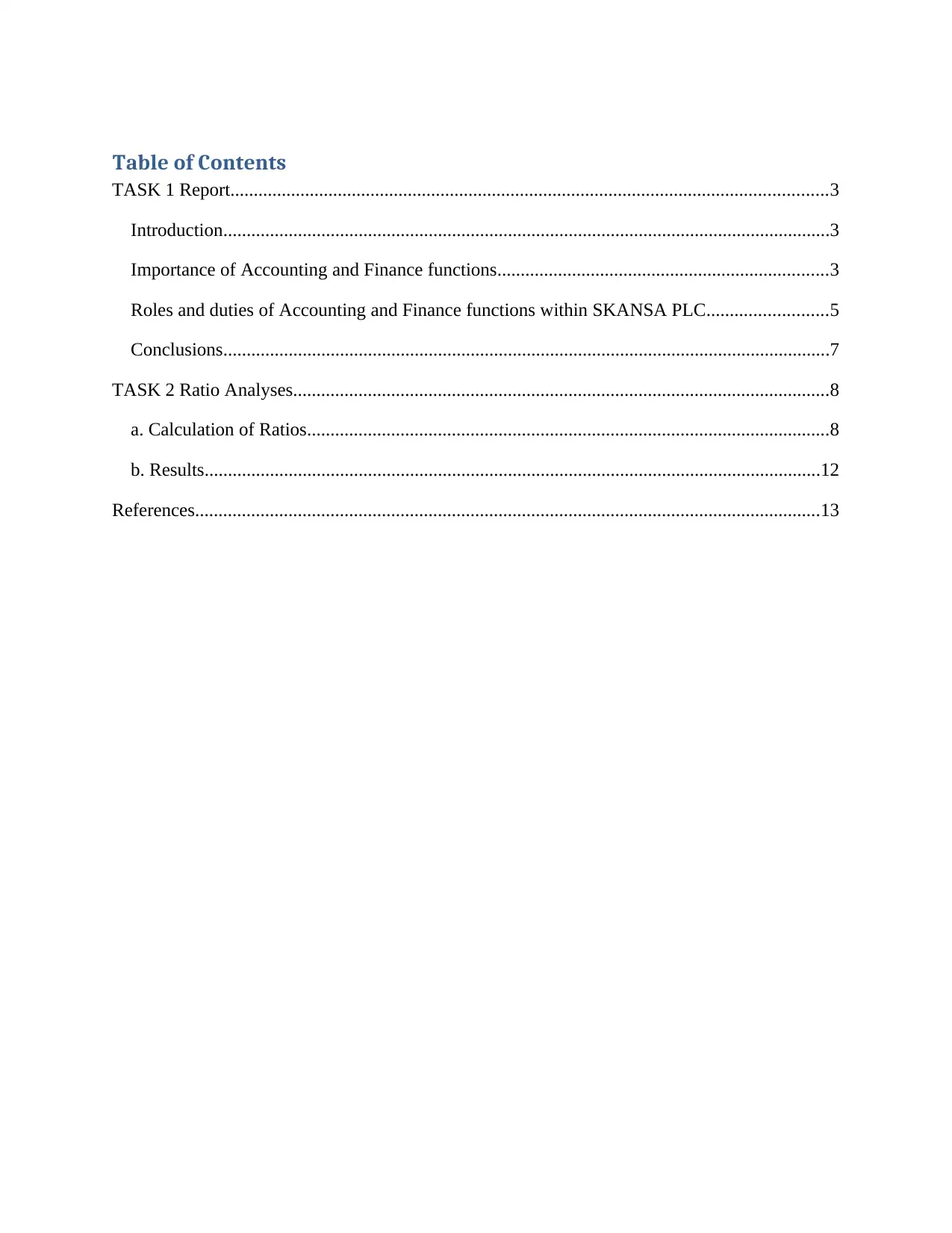
Table of Contents
TASK 1 Report................................................................................................................................3
Introduction..................................................................................................................................3
Importance of Accounting and Finance functions.......................................................................3
Roles and duties of Accounting and Finance functions within SKANSA PLC..........................5
Conclusions..................................................................................................................................7
TASK 2 Ratio Analyses...................................................................................................................8
a. Calculation of Ratios................................................................................................................8
b. Results....................................................................................................................................12
References......................................................................................................................................13
TASK 1 Report................................................................................................................................3
Introduction..................................................................................................................................3
Importance of Accounting and Finance functions.......................................................................3
Roles and duties of Accounting and Finance functions within SKANSA PLC..........................5
Conclusions..................................................................................................................................7
TASK 2 Ratio Analyses...................................................................................................................8
a. Calculation of Ratios................................................................................................................8
b. Results....................................................................................................................................12
References......................................................................................................................................13
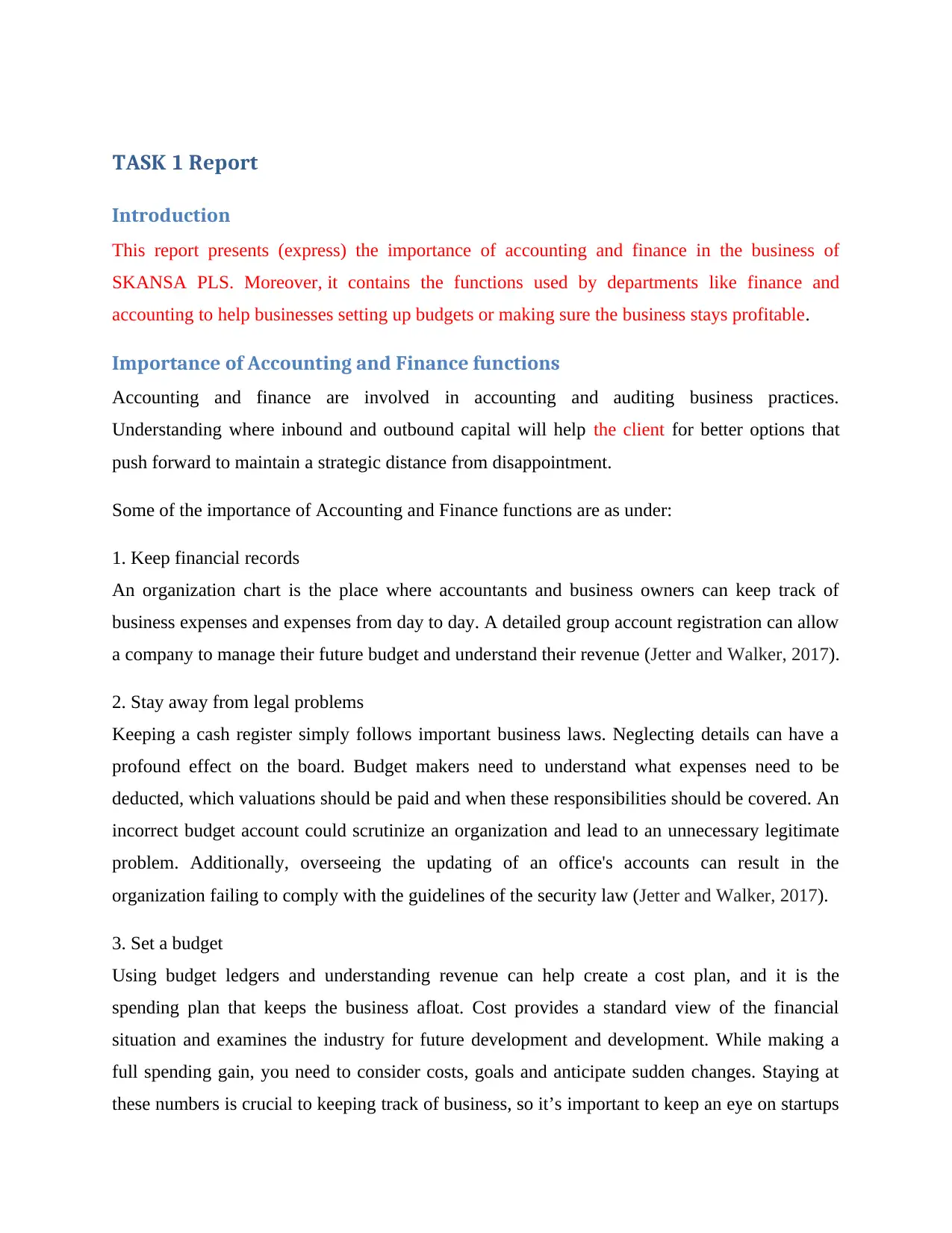
TASK 1 Report
Introduction
This report presents (express) the importance of accounting and finance in the business of
SKANSA PLS. Moreover, it contains the functions used by departments like finance and
accounting to help businesses setting up budgets or making sure the business stays profitable.
Importance of Accounting and Finance functions
Accounting and finance are involved in accounting and auditing business practices.
Understanding where inbound and outbound capital will help the client for better options that
push forward to maintain a strategic distance from disappointment.
Some of the importance of Accounting and Finance functions are as under:
1. Keep financial records
An organization chart is the place where accountants and business owners can keep track of
business expenses and expenses from day to day. A detailed group account registration can allow
a company to manage their future budget and understand their revenue (Jetter and Walker, 2017).
2. Stay away from legal problems
Keeping a cash register simply follows important business laws. Neglecting details can have a
profound effect on the board. Budget makers need to understand what expenses need to be
deducted, which valuations should be paid and when these responsibilities should be covered. An
incorrect budget account could scrutinize an organization and lead to an unnecessary legitimate
problem. Additionally, overseeing the updating of an office's accounts can result in the
organization failing to comply with the guidelines of the security law (Jetter and Walker, 2017).
3. Set a budget
Using budget ledgers and understanding revenue can help create a cost plan, and it is the
spending plan that keeps the business afloat. Cost provides a standard view of the financial
situation and examines the industry for future development and development. While making a
full spending gain, you need to consider costs, goals and anticipate sudden changes. Staying at
these numbers is crucial to keeping track of business, so it’s important to keep an eye on startups
Introduction
This report presents (express) the importance of accounting and finance in the business of
SKANSA PLS. Moreover, it contains the functions used by departments like finance and
accounting to help businesses setting up budgets or making sure the business stays profitable.
Importance of Accounting and Finance functions
Accounting and finance are involved in accounting and auditing business practices.
Understanding where inbound and outbound capital will help the client for better options that
push forward to maintain a strategic distance from disappointment.
Some of the importance of Accounting and Finance functions are as under:
1. Keep financial records
An organization chart is the place where accountants and business owners can keep track of
business expenses and expenses from day to day. A detailed group account registration can allow
a company to manage their future budget and understand their revenue (Jetter and Walker, 2017).
2. Stay away from legal problems
Keeping a cash register simply follows important business laws. Neglecting details can have a
profound effect on the board. Budget makers need to understand what expenses need to be
deducted, which valuations should be paid and when these responsibilities should be covered. An
incorrect budget account could scrutinize an organization and lead to an unnecessary legitimate
problem. Additionally, overseeing the updating of an office's accounts can result in the
organization failing to comply with the guidelines of the security law (Jetter and Walker, 2017).
3. Set a budget
Using budget ledgers and understanding revenue can help create a cost plan, and it is the
spending plan that keeps the business afloat. Cost provides a standard view of the financial
situation and examines the industry for future development and development. While making a
full spending gain, you need to consider costs, goals and anticipate sudden changes. Staying at
these numbers is crucial to keeping track of business, so it’s important to keep an eye on startups
⊘ This is a preview!⊘
Do you want full access?
Subscribe today to unlock all pages.

Trusted by 1+ million students worldwide
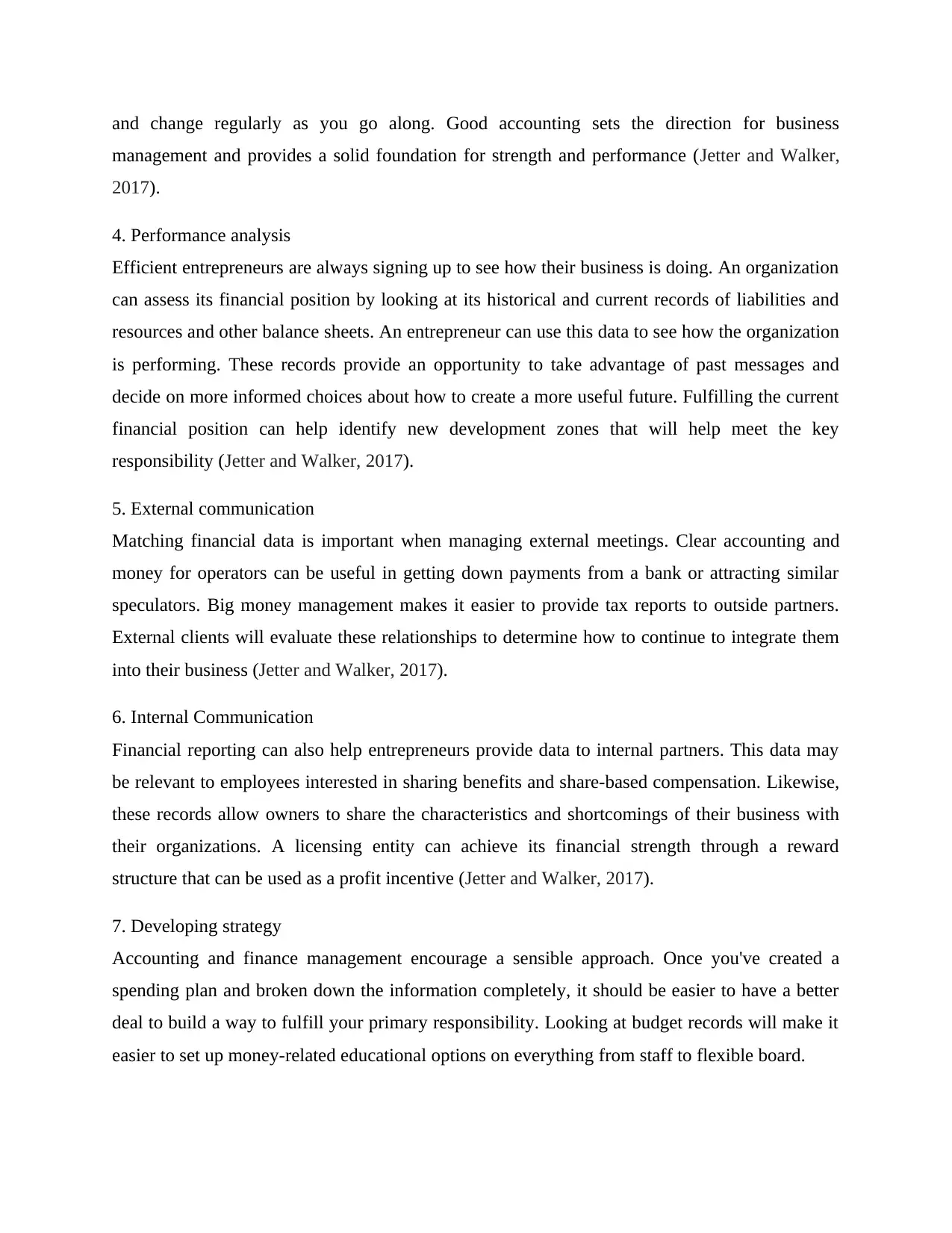
and change regularly as you go along. Good accounting sets the direction for business
management and provides a solid foundation for strength and performance (Jetter and Walker,
2017).
4. Performance analysis
Efficient entrepreneurs are always signing up to see how their business is doing. An organization
can assess its financial position by looking at its historical and current records of liabilities and
resources and other balance sheets. An entrepreneur can use this data to see how the organization
is performing. These records provide an opportunity to take advantage of past messages and
decide on more informed choices about how to create a more useful future. Fulfilling the current
financial position can help identify new development zones that will help meet the key
responsibility (Jetter and Walker, 2017).
5. External communication
Matching financial data is important when managing external meetings. Clear accounting and
money for operators can be useful in getting down payments from a bank or attracting similar
speculators. Big money management makes it easier to provide tax reports to outside partners.
External clients will evaluate these relationships to determine how to continue to integrate them
into their business (Jetter and Walker, 2017).
6. Internal Communication
Financial reporting can also help entrepreneurs provide data to internal partners. This data may
be relevant to employees interested in sharing benefits and share-based compensation. Likewise,
these records allow owners to share the characteristics and shortcomings of their business with
their organizations. A licensing entity can achieve its financial strength through a reward
structure that can be used as a profit incentive (Jetter and Walker, 2017).
7. Developing strategy
Accounting and finance management encourage a sensible approach. Once you've created a
spending plan and broken down the information completely, it should be easier to have a better
deal to build a way to fulfill your primary responsibility. Looking at budget records will make it
easier to set up money-related educational options on everything from staff to flexible board.
management and provides a solid foundation for strength and performance (Jetter and Walker,
2017).
4. Performance analysis
Efficient entrepreneurs are always signing up to see how their business is doing. An organization
can assess its financial position by looking at its historical and current records of liabilities and
resources and other balance sheets. An entrepreneur can use this data to see how the organization
is performing. These records provide an opportunity to take advantage of past messages and
decide on more informed choices about how to create a more useful future. Fulfilling the current
financial position can help identify new development zones that will help meet the key
responsibility (Jetter and Walker, 2017).
5. External communication
Matching financial data is important when managing external meetings. Clear accounting and
money for operators can be useful in getting down payments from a bank or attracting similar
speculators. Big money management makes it easier to provide tax reports to outside partners.
External clients will evaluate these relationships to determine how to continue to integrate them
into their business (Jetter and Walker, 2017).
6. Internal Communication
Financial reporting can also help entrepreneurs provide data to internal partners. This data may
be relevant to employees interested in sharing benefits and share-based compensation. Likewise,
these records allow owners to share the characteristics and shortcomings of their business with
their organizations. A licensing entity can achieve its financial strength through a reward
structure that can be used as a profit incentive (Jetter and Walker, 2017).
7. Developing strategy
Accounting and finance management encourage a sensible approach. Once you've created a
spending plan and broken down the information completely, it should be easier to have a better
deal to build a way to fulfill your primary responsibility. Looking at budget records will make it
easier to set up money-related educational options on everything from staff to flexible board.
Paraphrase This Document
Need a fresh take? Get an instant paraphrase of this document with our AI Paraphraser
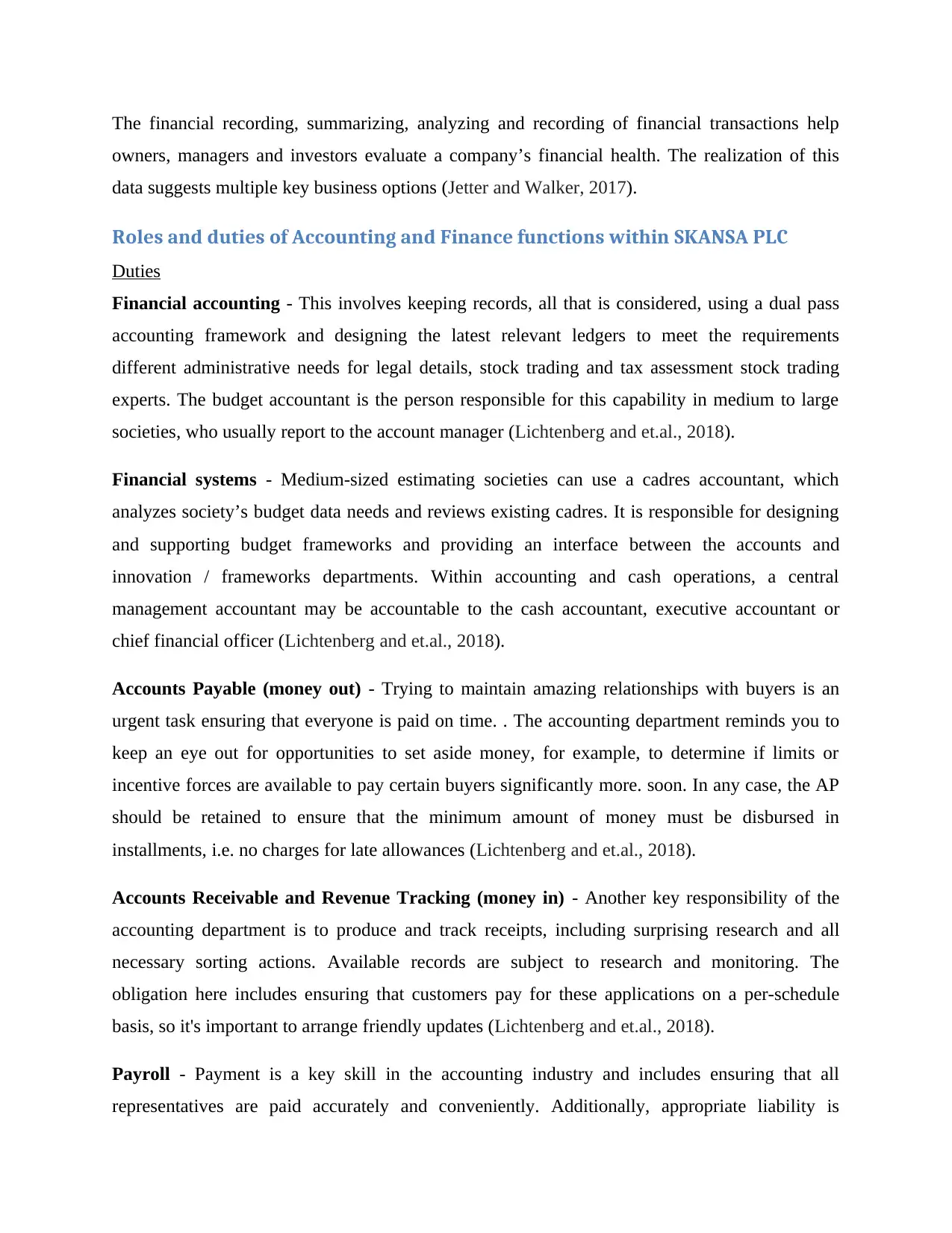
The financial recording, summarizing, analyzing and recording of financial transactions help
owners, managers and investors evaluate a company’s financial health. The realization of this
data suggests multiple key business options (Jetter and Walker, 2017).
Roles and duties of Accounting and Finance functions within SKANSA PLC
Duties
Financial accounting - This involves keeping records, all that is considered, using a dual pass
accounting framework and designing the latest relevant ledgers to meet the requirements
different administrative needs for legal details, stock trading and tax assessment stock trading
experts. The budget accountant is the person responsible for this capability in medium to large
societies, who usually report to the account manager (Lichtenberg and et.al., 2018).
Financial systems - Medium-sized estimating societies can use a cadres accountant, which
analyzes society’s budget data needs and reviews existing cadres. It is responsible for designing
and supporting budget frameworks and providing an interface between the accounts and
innovation / frameworks departments. Within accounting and cash operations, a central
management accountant may be accountable to the cash accountant, executive accountant or
chief financial officer (Lichtenberg and et.al., 2018).
Accounts Payable (money out) - Trying to maintain amazing relationships with buyers is an
urgent task ensuring that everyone is paid on time. . The accounting department reminds you to
keep an eye out for opportunities to set aside money, for example, to determine if limits or
incentive forces are available to pay certain buyers significantly more. soon. In any case, the AP
should be retained to ensure that the minimum amount of money must be disbursed in
installments, i.e. no charges for late allowances (Lichtenberg and et.al., 2018).
Accounts Receivable and Revenue Tracking (money in) - Another key responsibility of the
accounting department is to produce and track receipts, including surprising research and all
necessary sorting actions. Available records are subject to research and monitoring. The
obligation here includes ensuring that customers pay for these applications on a per-schedule
basis, so it's important to arrange friendly updates (Lichtenberg and et.al., 2018).
Payroll - Payment is a key skill in the accounting industry and includes ensuring that all
representatives are paid accurately and conveniently. Additionally, appropriate liability is
owners, managers and investors evaluate a company’s financial health. The realization of this
data suggests multiple key business options (Jetter and Walker, 2017).
Roles and duties of Accounting and Finance functions within SKANSA PLC
Duties
Financial accounting - This involves keeping records, all that is considered, using a dual pass
accounting framework and designing the latest relevant ledgers to meet the requirements
different administrative needs for legal details, stock trading and tax assessment stock trading
experts. The budget accountant is the person responsible for this capability in medium to large
societies, who usually report to the account manager (Lichtenberg and et.al., 2018).
Financial systems - Medium-sized estimating societies can use a cadres accountant, which
analyzes society’s budget data needs and reviews existing cadres. It is responsible for designing
and supporting budget frameworks and providing an interface between the accounts and
innovation / frameworks departments. Within accounting and cash operations, a central
management accountant may be accountable to the cash accountant, executive accountant or
chief financial officer (Lichtenberg and et.al., 2018).
Accounts Payable (money out) - Trying to maintain amazing relationships with buyers is an
urgent task ensuring that everyone is paid on time. . The accounting department reminds you to
keep an eye out for opportunities to set aside money, for example, to determine if limits or
incentive forces are available to pay certain buyers significantly more. soon. In any case, the AP
should be retained to ensure that the minimum amount of money must be disbursed in
installments, i.e. no charges for late allowances (Lichtenberg and et.al., 2018).
Accounts Receivable and Revenue Tracking (money in) - Another key responsibility of the
accounting department is to produce and track receipts, including surprising research and all
necessary sorting actions. Available records are subject to research and monitoring. The
obligation here includes ensuring that customers pay for these applications on a per-schedule
basis, so it's important to arrange friendly updates (Lichtenberg and et.al., 2018).
Payroll - Payment is a key skill in the accounting industry and includes ensuring that all
representatives are paid accurately and conveniently. Additionally, appropriate liability is
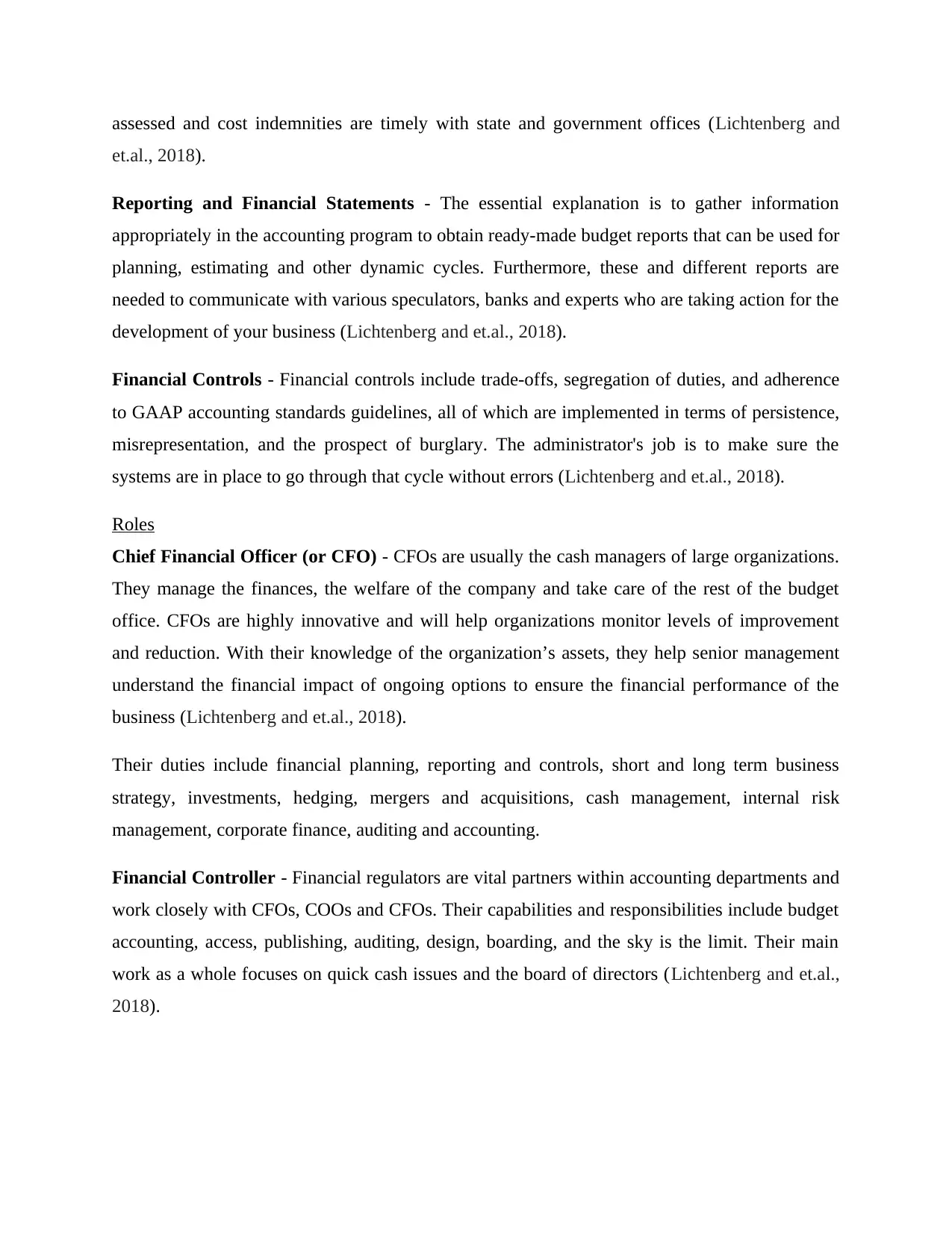
assessed and cost indemnities are timely with state and government offices (Lichtenberg and
et.al., 2018).
Reporting and Financial Statements - The essential explanation is to gather information
appropriately in the accounting program to obtain ready-made budget reports that can be used for
planning, estimating and other dynamic cycles. Furthermore, these and different reports are
needed to communicate with various speculators, banks and experts who are taking action for the
development of your business (Lichtenberg and et.al., 2018).
Financial Controls - Financial controls include trade-offs, segregation of duties, and adherence
to GAAP accounting standards guidelines, all of which are implemented in terms of persistence,
misrepresentation, and the prospect of burglary. The administrator's job is to make sure the
systems are in place to go through that cycle without errors (Lichtenberg and et.al., 2018).
Roles
Chief Financial Officer (or CFO) - CFOs are usually the cash managers of large organizations.
They manage the finances, the welfare of the company and take care of the rest of the budget
office. CFOs are highly innovative and will help organizations monitor levels of improvement
and reduction. With their knowledge of the organization’s assets, they help senior management
understand the financial impact of ongoing options to ensure the financial performance of the
business (Lichtenberg and et.al., 2018).
Their duties include financial planning, reporting and controls, short and long term business
strategy, investments, hedging, mergers and acquisitions, cash management, internal risk
management, corporate finance, auditing and accounting.
Financial Controller - Financial regulators are vital partners within accounting departments and
work closely with CFOs, COOs and CFOs. Their capabilities and responsibilities include budget
accounting, access, publishing, auditing, design, boarding, and the sky is the limit. Their main
work as a whole focuses on quick cash issues and the board of directors (Lichtenberg and et.al.,
2018).
et.al., 2018).
Reporting and Financial Statements - The essential explanation is to gather information
appropriately in the accounting program to obtain ready-made budget reports that can be used for
planning, estimating and other dynamic cycles. Furthermore, these and different reports are
needed to communicate with various speculators, banks and experts who are taking action for the
development of your business (Lichtenberg and et.al., 2018).
Financial Controls - Financial controls include trade-offs, segregation of duties, and adherence
to GAAP accounting standards guidelines, all of which are implemented in terms of persistence,
misrepresentation, and the prospect of burglary. The administrator's job is to make sure the
systems are in place to go through that cycle without errors (Lichtenberg and et.al., 2018).
Roles
Chief Financial Officer (or CFO) - CFOs are usually the cash managers of large organizations.
They manage the finances, the welfare of the company and take care of the rest of the budget
office. CFOs are highly innovative and will help organizations monitor levels of improvement
and reduction. With their knowledge of the organization’s assets, they help senior management
understand the financial impact of ongoing options to ensure the financial performance of the
business (Lichtenberg and et.al., 2018).
Their duties include financial planning, reporting and controls, short and long term business
strategy, investments, hedging, mergers and acquisitions, cash management, internal risk
management, corporate finance, auditing and accounting.
Financial Controller - Financial regulators are vital partners within accounting departments and
work closely with CFOs, COOs and CFOs. Their capabilities and responsibilities include budget
accounting, access, publishing, auditing, design, boarding, and the sky is the limit. Their main
work as a whole focuses on quick cash issues and the board of directors (Lichtenberg and et.al.,
2018).
⊘ This is a preview!⊘
Do you want full access?
Subscribe today to unlock all pages.

Trusted by 1+ million students worldwide
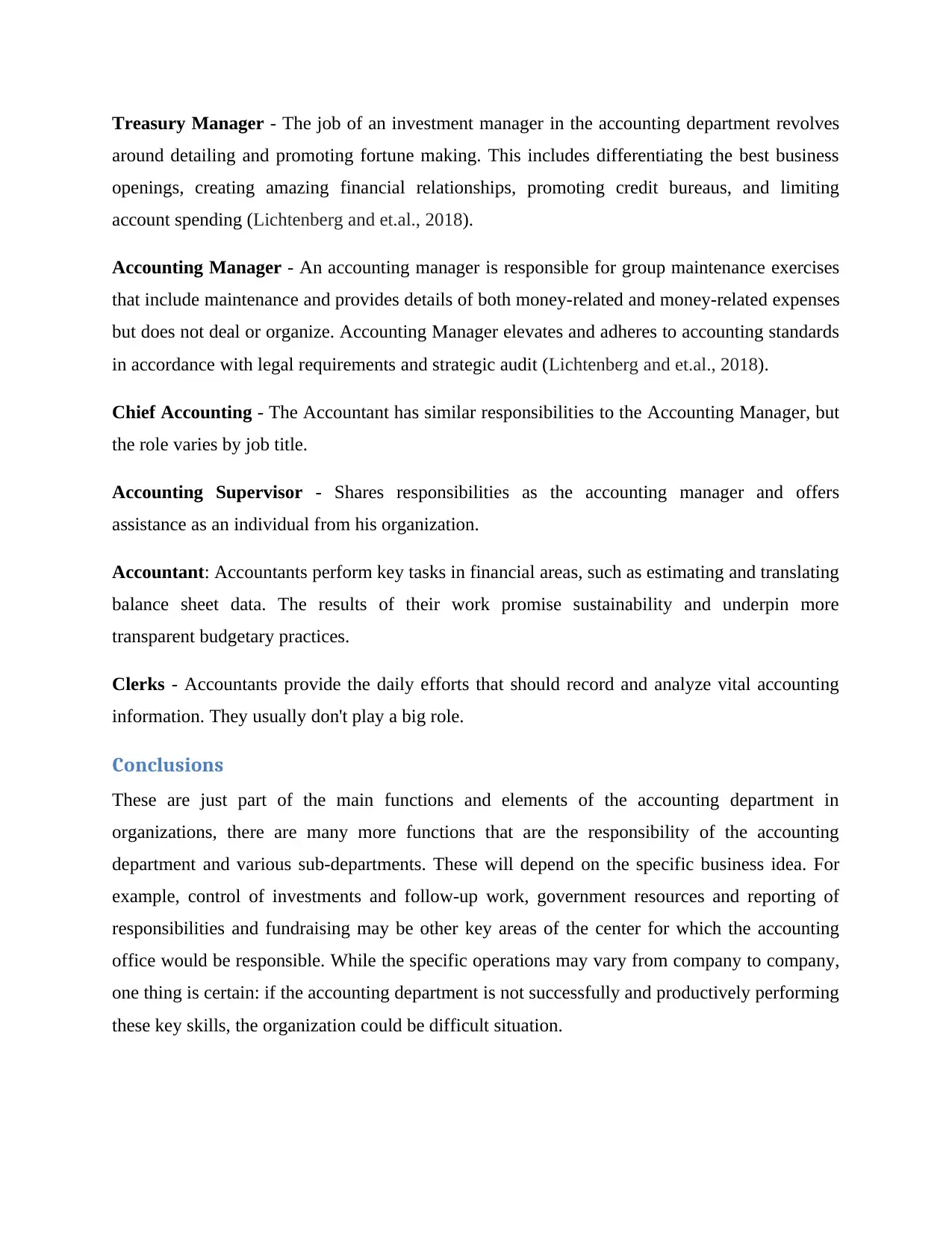
Treasury Manager - The job of an investment manager in the accounting department revolves
around detailing and promoting fortune making. This includes differentiating the best business
openings, creating amazing financial relationships, promoting credit bureaus, and limiting
account spending (Lichtenberg and et.al., 2018).
Accounting Manager - An accounting manager is responsible for group maintenance exercises
that include maintenance and provides details of both money-related and money-related expenses
but does not deal or organize. Accounting Manager elevates and adheres to accounting standards
in accordance with legal requirements and strategic audit (Lichtenberg and et.al., 2018).
Chief Accounting - The Accountant has similar responsibilities to the Accounting Manager, but
the role varies by job title.
Accounting Supervisor - Shares responsibilities as the accounting manager and offers
assistance as an individual from his organization.
Accountant: Accountants perform key tasks in financial areas, such as estimating and translating
balance sheet data. The results of their work promise sustainability and underpin more
transparent budgetary practices.
Clerks - Accountants provide the daily efforts that should record and analyze vital accounting
information. They usually don't play a big role.
Conclusions
These are just part of the main functions and elements of the accounting department in
organizations, there are many more functions that are the responsibility of the accounting
department and various sub-departments. These will depend on the specific business idea. For
example, control of investments and follow-up work, government resources and reporting of
responsibilities and fundraising may be other key areas of the center for which the accounting
office would be responsible. While the specific operations may vary from company to company,
one thing is certain: if the accounting department is not successfully and productively performing
these key skills, the organization could be difficult situation.
around detailing and promoting fortune making. This includes differentiating the best business
openings, creating amazing financial relationships, promoting credit bureaus, and limiting
account spending (Lichtenberg and et.al., 2018).
Accounting Manager - An accounting manager is responsible for group maintenance exercises
that include maintenance and provides details of both money-related and money-related expenses
but does not deal or organize. Accounting Manager elevates and adheres to accounting standards
in accordance with legal requirements and strategic audit (Lichtenberg and et.al., 2018).
Chief Accounting - The Accountant has similar responsibilities to the Accounting Manager, but
the role varies by job title.
Accounting Supervisor - Shares responsibilities as the accounting manager and offers
assistance as an individual from his organization.
Accountant: Accountants perform key tasks in financial areas, such as estimating and translating
balance sheet data. The results of their work promise sustainability and underpin more
transparent budgetary practices.
Clerks - Accountants provide the daily efforts that should record and analyze vital accounting
information. They usually don't play a big role.
Conclusions
These are just part of the main functions and elements of the accounting department in
organizations, there are many more functions that are the responsibility of the accounting
department and various sub-departments. These will depend on the specific business idea. For
example, control of investments and follow-up work, government resources and reporting of
responsibilities and fundraising may be other key areas of the center for which the accounting
office would be responsible. While the specific operations may vary from company to company,
one thing is certain: if the accounting department is not successfully and productively performing
these key skills, the organization could be difficult situation.
Paraphrase This Document
Need a fresh take? Get an instant paraphrase of this document with our AI Paraphraser
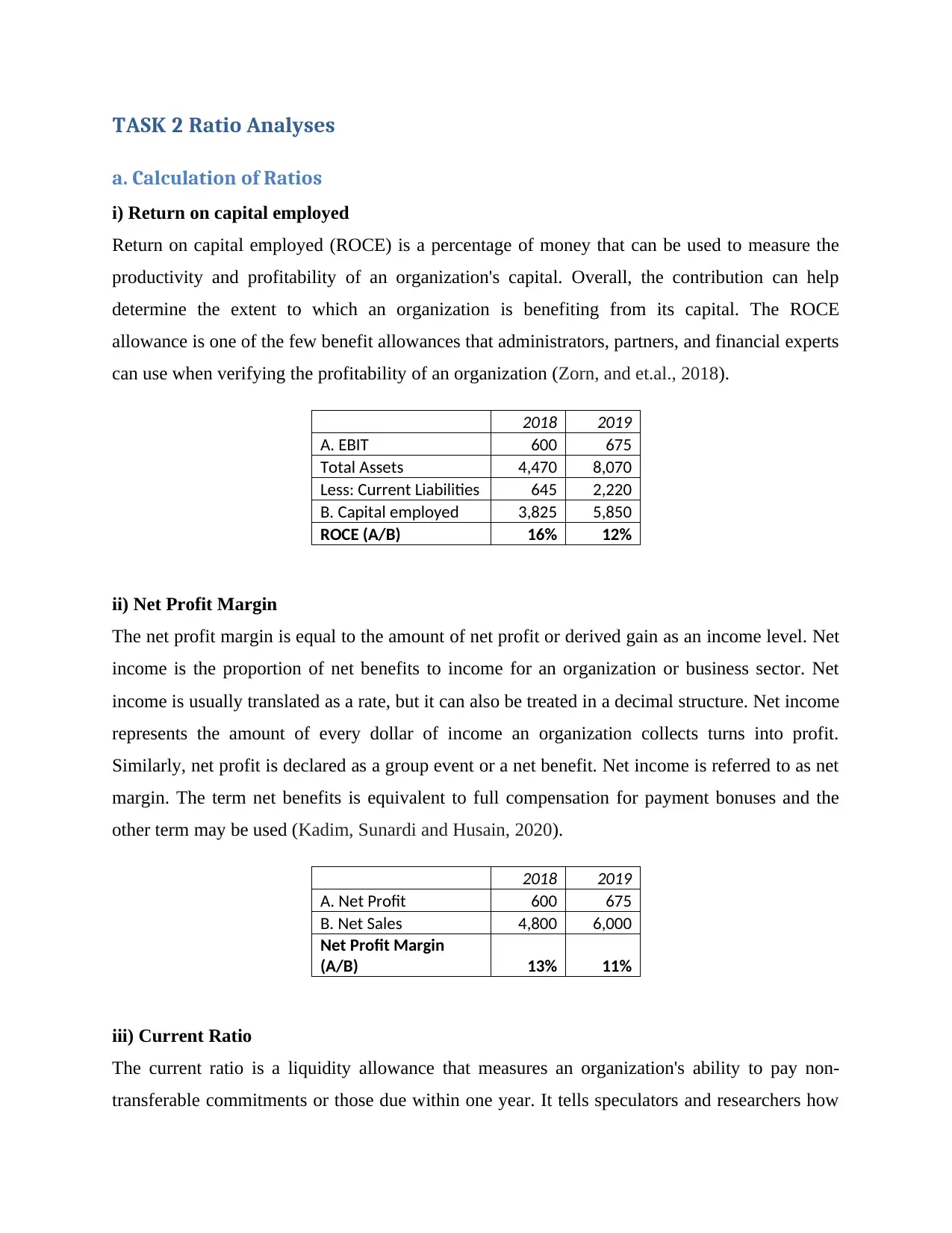
TASK 2 Ratio Analyses
a. Calculation of Ratios
i) Return on capital employed
Return on capital employed (ROCE) is a percentage of money that can be used to measure the
productivity and profitability of an organization's capital. Overall, the contribution can help
determine the extent to which an organization is benefiting from its capital. The ROCE
allowance is one of the few benefit allowances that administrators, partners, and financial experts
can use when verifying the profitability of an organization (Zorn, and et.al., 2018).
2018 2019
A. EBIT 600 675
Total Assets 4,470 8,070
Less: Current Liabilities 645 2,220
B. Capital employed 3,825 5,850
ROCE (A/B) 16% 12%
ii) Net Profit Margin
The net profit margin is equal to the amount of net profit or derived gain as an income level. Net
income is the proportion of net benefits to income for an organization or business sector. Net
income is usually translated as a rate, but it can also be treated in a decimal structure. Net income
represents the amount of every dollar of income an organization collects turns into profit.
Similarly, net profit is declared as a group event or a net benefit. Net income is referred to as net
margin. The term net benefits is equivalent to full compensation for payment bonuses and the
other term may be used (Kadim, Sunardi and Husain, 2020).
2018 2019
A. Net Profit 600 675
B. Net Sales 4,800 6,000
Net Profit Margin
(A/B) 13% 11%
iii) Current Ratio
The current ratio is a liquidity allowance that measures an organization's ability to pay non-
transferable commitments or those due within one year. It tells speculators and researchers how
a. Calculation of Ratios
i) Return on capital employed
Return on capital employed (ROCE) is a percentage of money that can be used to measure the
productivity and profitability of an organization's capital. Overall, the contribution can help
determine the extent to which an organization is benefiting from its capital. The ROCE
allowance is one of the few benefit allowances that administrators, partners, and financial experts
can use when verifying the profitability of an organization (Zorn, and et.al., 2018).
2018 2019
A. EBIT 600 675
Total Assets 4,470 8,070
Less: Current Liabilities 645 2,220
B. Capital employed 3,825 5,850
ROCE (A/B) 16% 12%
ii) Net Profit Margin
The net profit margin is equal to the amount of net profit or derived gain as an income level. Net
income is the proportion of net benefits to income for an organization or business sector. Net
income is usually translated as a rate, but it can also be treated in a decimal structure. Net income
represents the amount of every dollar of income an organization collects turns into profit.
Similarly, net profit is declared as a group event or a net benefit. Net income is referred to as net
margin. The term net benefits is equivalent to full compensation for payment bonuses and the
other term may be used (Kadim, Sunardi and Husain, 2020).
2018 2019
A. Net Profit 600 675
B. Net Sales 4,800 6,000
Net Profit Margin
(A/B) 13% 11%
iii) Current Ratio
The current ratio is a liquidity allowance that measures an organization's ability to pay non-
transferable commitments or those due within one year. It tells speculators and researchers how
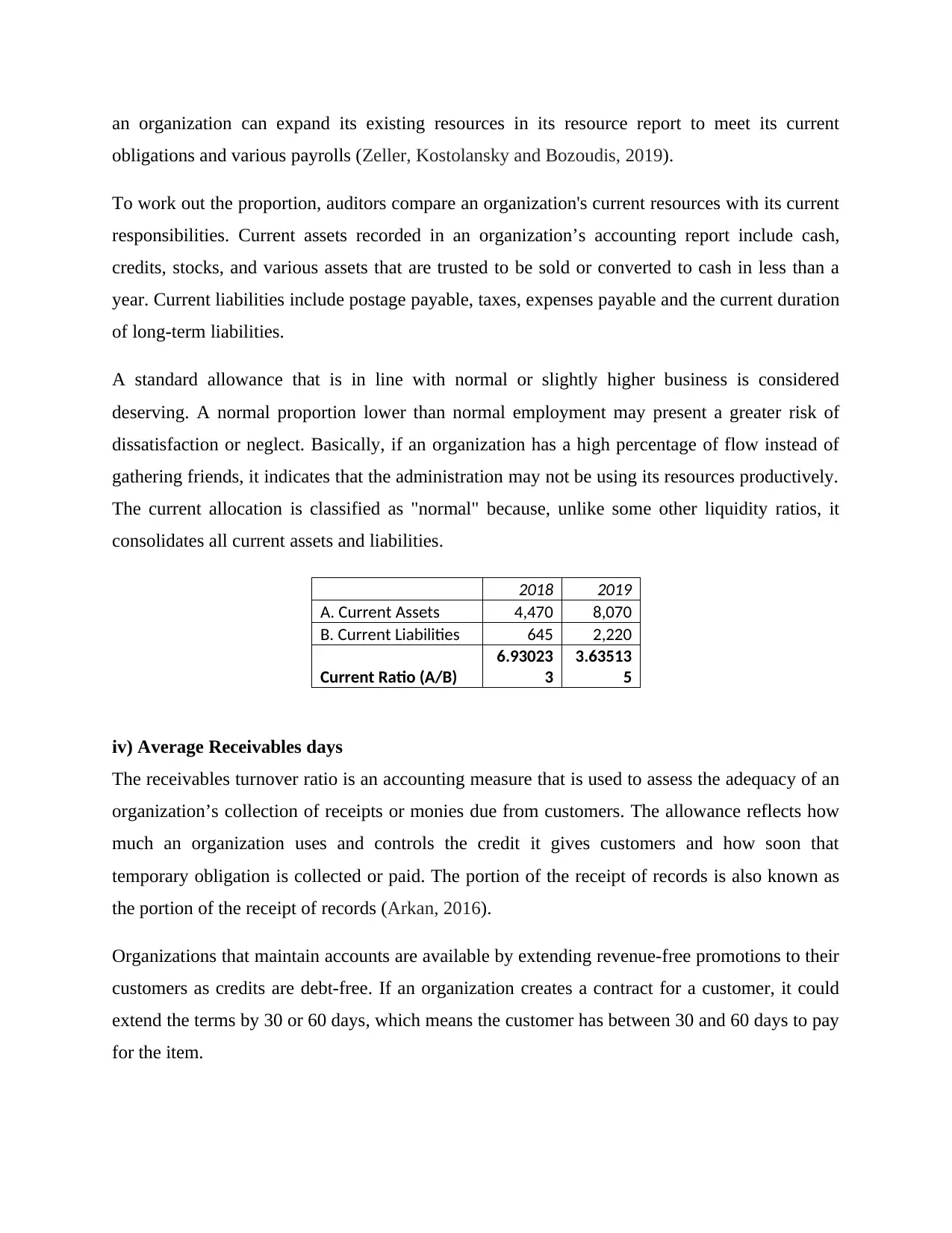
an organization can expand its existing resources in its resource report to meet its current
obligations and various payrolls (Zeller, Kostolansky and Bozoudis, 2019).
To work out the proportion, auditors compare an organization's current resources with its current
responsibilities. Current assets recorded in an organization’s accounting report include cash,
credits, stocks, and various assets that are trusted to be sold or converted to cash in less than a
year. Current liabilities include postage payable, taxes, expenses payable and the current duration
of long-term liabilities.
A standard allowance that is in line with normal or slightly higher business is considered
deserving. A normal proportion lower than normal employment may present a greater risk of
dissatisfaction or neglect. Basically, if an organization has a high percentage of flow instead of
gathering friends, it indicates that the administration may not be using its resources productively.
The current allocation is classified as "normal" because, unlike some other liquidity ratios, it
consolidates all current assets and liabilities.
2018 2019
A. Current Assets 4,470 8,070
B. Current Liabilities 645 2,220
Current Ratio (A/B)
6.93023
3
3.63513
5
iv) Average Receivables days
The receivables turnover ratio is an accounting measure that is used to assess the adequacy of an
organization’s collection of receipts or monies due from customers. The allowance reflects how
much an organization uses and controls the credit it gives customers and how soon that
temporary obligation is collected or paid. The portion of the receipt of records is also known as
the portion of the receipt of records (Arkan, 2016).
Organizations that maintain accounts are available by extending revenue-free promotions to their
customers as credits are debt-free. If an organization creates a contract for a customer, it could
extend the terms by 30 or 60 days, which means the customer has between 30 and 60 days to pay
for the item.
obligations and various payrolls (Zeller, Kostolansky and Bozoudis, 2019).
To work out the proportion, auditors compare an organization's current resources with its current
responsibilities. Current assets recorded in an organization’s accounting report include cash,
credits, stocks, and various assets that are trusted to be sold or converted to cash in less than a
year. Current liabilities include postage payable, taxes, expenses payable and the current duration
of long-term liabilities.
A standard allowance that is in line with normal or slightly higher business is considered
deserving. A normal proportion lower than normal employment may present a greater risk of
dissatisfaction or neglect. Basically, if an organization has a high percentage of flow instead of
gathering friends, it indicates that the administration may not be using its resources productively.
The current allocation is classified as "normal" because, unlike some other liquidity ratios, it
consolidates all current assets and liabilities.
2018 2019
A. Current Assets 4,470 8,070
B. Current Liabilities 645 2,220
Current Ratio (A/B)
6.93023
3
3.63513
5
iv) Average Receivables days
The receivables turnover ratio is an accounting measure that is used to assess the adequacy of an
organization’s collection of receipts or monies due from customers. The allowance reflects how
much an organization uses and controls the credit it gives customers and how soon that
temporary obligation is collected or paid. The portion of the receipt of records is also known as
the portion of the receipt of records (Arkan, 2016).
Organizations that maintain accounts are available by extending revenue-free promotions to their
customers as credits are debt-free. If an organization creates a contract for a customer, it could
extend the terms by 30 or 60 days, which means the customer has between 30 and 60 days to pay
for the item.
⊘ This is a preview!⊘
Do you want full access?
Subscribe today to unlock all pages.

Trusted by 1+ million students worldwide
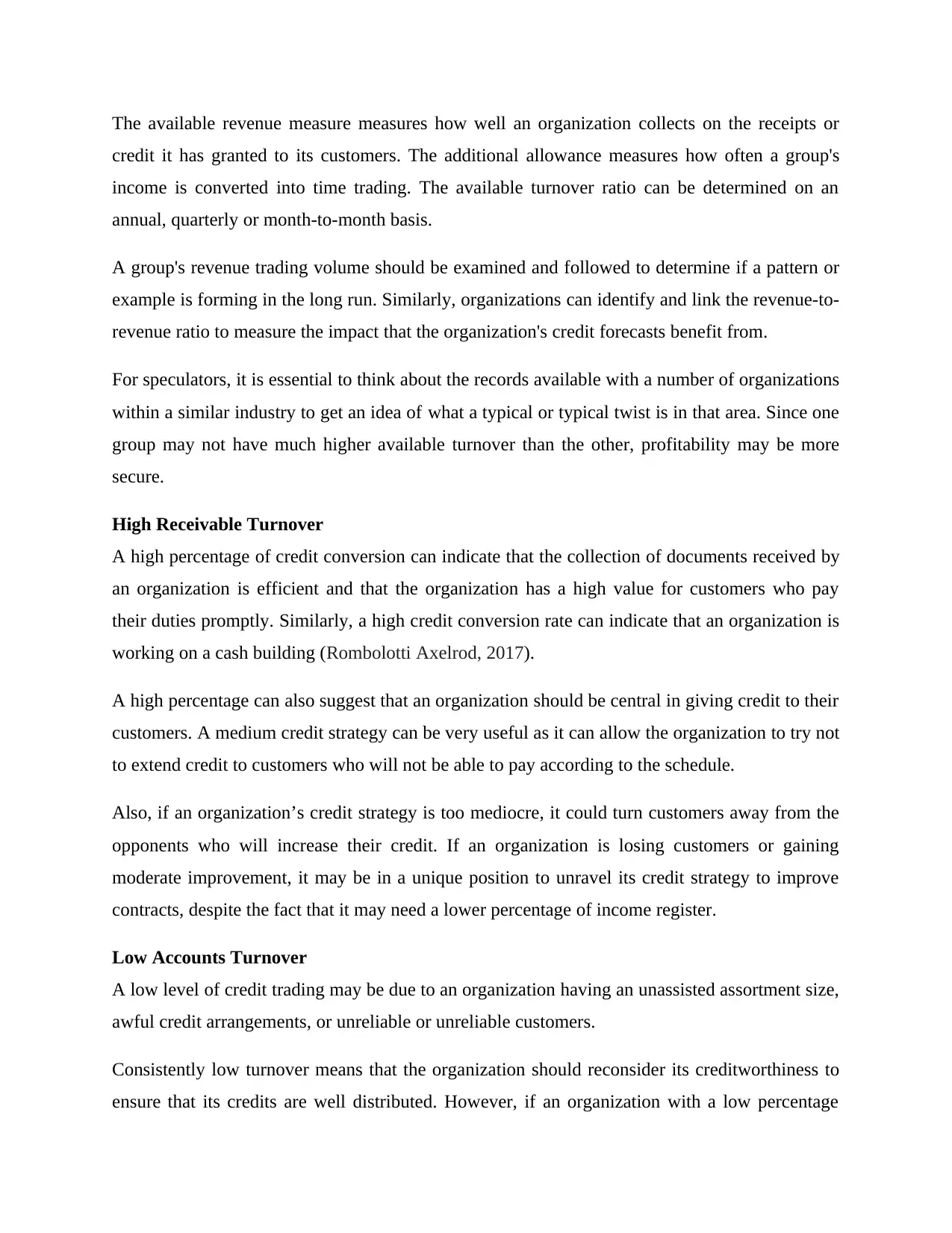
The available revenue measure measures how well an organization collects on the receipts or
credit it has granted to its customers. The additional allowance measures how often a group's
income is converted into time trading. The available turnover ratio can be determined on an
annual, quarterly or month-to-month basis.
A group's revenue trading volume should be examined and followed to determine if a pattern or
example is forming in the long run. Similarly, organizations can identify and link the revenue-to-
revenue ratio to measure the impact that the organization's credit forecasts benefit from.
For speculators, it is essential to think about the records available with a number of organizations
within a similar industry to get an idea of what a typical or typical twist is in that area. Since one
group may not have much higher available turnover than the other, profitability may be more
secure.
High Receivable Turnover
A high percentage of credit conversion can indicate that the collection of documents received by
an organization is efficient and that the organization has a high value for customers who pay
their duties promptly. Similarly, a high credit conversion rate can indicate that an organization is
working on a cash building (Rombolotti Axelrod, 2017).
A high percentage can also suggest that an organization should be central in giving credit to their
customers. A medium credit strategy can be very useful as it can allow the organization to try not
to extend credit to customers who will not be able to pay according to the schedule.
Also, if an organization’s credit strategy is too mediocre, it could turn customers away from the
opponents who will increase their credit. If an organization is losing customers or gaining
moderate improvement, it may be in a unique position to unravel its credit strategy to improve
contracts, despite the fact that it may need a lower percentage of income register.
Low Accounts Turnover
A low level of credit trading may be due to an organization having an unassisted assortment size,
awful credit arrangements, or unreliable or unreliable customers.
Consistently low turnover means that the organization should reconsider its creditworthiness to
ensure that its credits are well distributed. However, if an organization with a low percentage
credit it has granted to its customers. The additional allowance measures how often a group's
income is converted into time trading. The available turnover ratio can be determined on an
annual, quarterly or month-to-month basis.
A group's revenue trading volume should be examined and followed to determine if a pattern or
example is forming in the long run. Similarly, organizations can identify and link the revenue-to-
revenue ratio to measure the impact that the organization's credit forecasts benefit from.
For speculators, it is essential to think about the records available with a number of organizations
within a similar industry to get an idea of what a typical or typical twist is in that area. Since one
group may not have much higher available turnover than the other, profitability may be more
secure.
High Receivable Turnover
A high percentage of credit conversion can indicate that the collection of documents received by
an organization is efficient and that the organization has a high value for customers who pay
their duties promptly. Similarly, a high credit conversion rate can indicate that an organization is
working on a cash building (Rombolotti Axelrod, 2017).
A high percentage can also suggest that an organization should be central in giving credit to their
customers. A medium credit strategy can be very useful as it can allow the organization to try not
to extend credit to customers who will not be able to pay according to the schedule.
Also, if an organization’s credit strategy is too mediocre, it could turn customers away from the
opponents who will increase their credit. If an organization is losing customers or gaining
moderate improvement, it may be in a unique position to unravel its credit strategy to improve
contracts, despite the fact that it may need a lower percentage of income register.
Low Accounts Turnover
A low level of credit trading may be due to an organization having an unassisted assortment size,
awful credit arrangements, or unreliable or unreliable customers.
Consistently low turnover means that the organization should reconsider its creditworthiness to
ensure that its credits are well distributed. However, if an organization with a low percentage
Paraphrase This Document
Need a fresh take? Get an instant paraphrase of this document with our AI Paraphraser
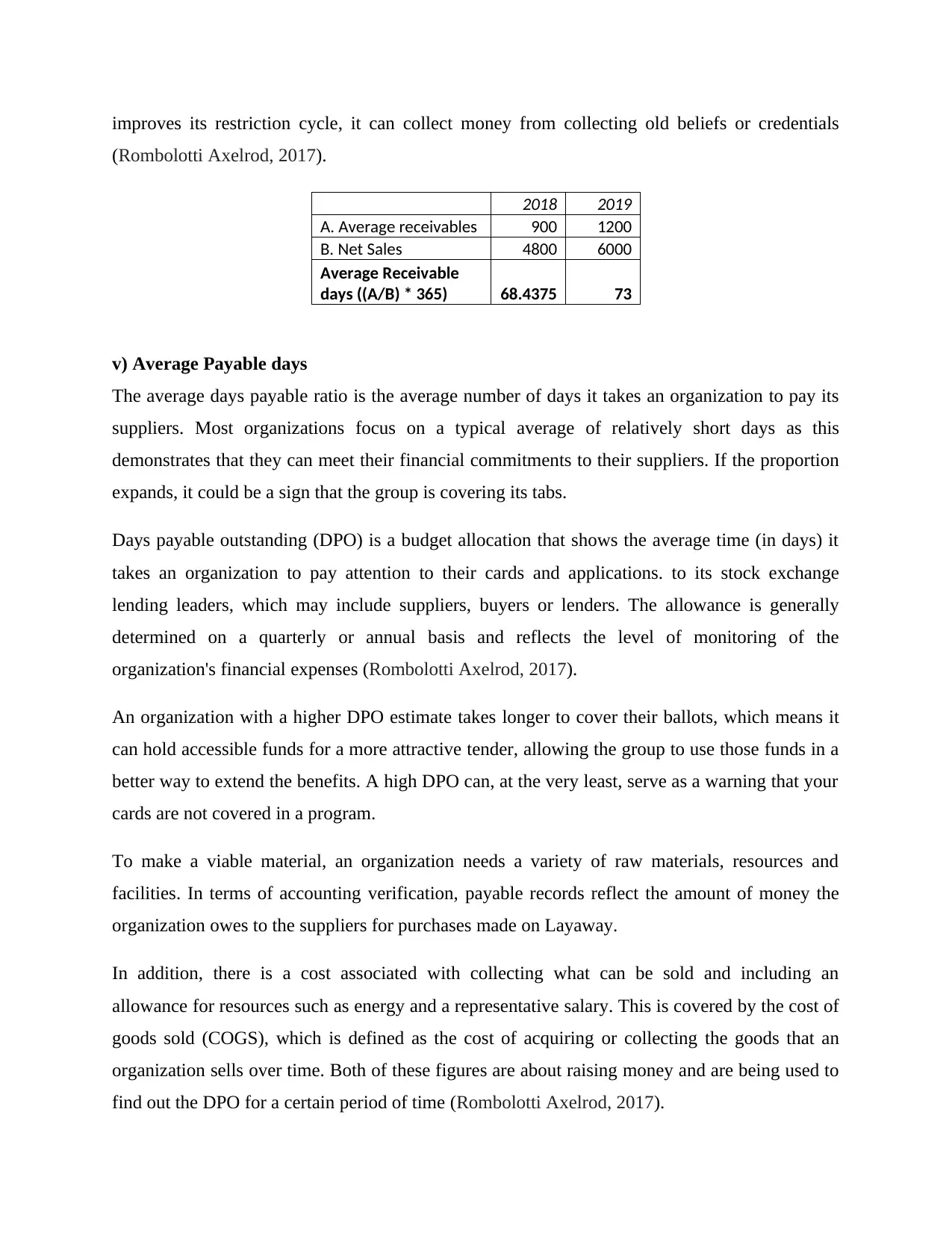
improves its restriction cycle, it can collect money from collecting old beliefs or credentials
(Rombolotti Axelrod, 2017).
2018 2019
A. Average receivables 900 1200
B. Net Sales 4800 6000
Average Receivable
days ((A/B) * 365) 68.4375 73
v) Average Payable days
The average days payable ratio is the average number of days it takes an organization to pay its
suppliers. Most organizations focus on a typical average of relatively short days as this
demonstrates that they can meet their financial commitments to their suppliers. If the proportion
expands, it could be a sign that the group is covering its tabs.
Days payable outstanding (DPO) is a budget allocation that shows the average time (in days) it
takes an organization to pay attention to their cards and applications. to its stock exchange
lending leaders, which may include suppliers, buyers or lenders. The allowance is generally
determined on a quarterly or annual basis and reflects the level of monitoring of the
organization's financial expenses (Rombolotti Axelrod, 2017).
An organization with a higher DPO estimate takes longer to cover their ballots, which means it
can hold accessible funds for a more attractive tender, allowing the group to use those funds in a
better way to extend the benefits. A high DPO can, at the very least, serve as a warning that your
cards are not covered in a program.
To make a viable material, an organization needs a variety of raw materials, resources and
facilities. In terms of accounting verification, payable records reflect the amount of money the
organization owes to the suppliers for purchases made on Layaway.
In addition, there is a cost associated with collecting what can be sold and including an
allowance for resources such as energy and a representative salary. This is covered by the cost of
goods sold (COGS), which is defined as the cost of acquiring or collecting the goods that an
organization sells over time. Both of these figures are about raising money and are being used to
find out the DPO for a certain period of time (Rombolotti Axelrod, 2017).
(Rombolotti Axelrod, 2017).
2018 2019
A. Average receivables 900 1200
B. Net Sales 4800 6000
Average Receivable
days ((A/B) * 365) 68.4375 73
v) Average Payable days
The average days payable ratio is the average number of days it takes an organization to pay its
suppliers. Most organizations focus on a typical average of relatively short days as this
demonstrates that they can meet their financial commitments to their suppliers. If the proportion
expands, it could be a sign that the group is covering its tabs.
Days payable outstanding (DPO) is a budget allocation that shows the average time (in days) it
takes an organization to pay attention to their cards and applications. to its stock exchange
lending leaders, which may include suppliers, buyers or lenders. The allowance is generally
determined on a quarterly or annual basis and reflects the level of monitoring of the
organization's financial expenses (Rombolotti Axelrod, 2017).
An organization with a higher DPO estimate takes longer to cover their ballots, which means it
can hold accessible funds for a more attractive tender, allowing the group to use those funds in a
better way to extend the benefits. A high DPO can, at the very least, serve as a warning that your
cards are not covered in a program.
To make a viable material, an organization needs a variety of raw materials, resources and
facilities. In terms of accounting verification, payable records reflect the amount of money the
organization owes to the suppliers for purchases made on Layaway.
In addition, there is a cost associated with collecting what can be sold and including an
allowance for resources such as energy and a representative salary. This is covered by the cost of
goods sold (COGS), which is defined as the cost of acquiring or collecting the goods that an
organization sells over time. Both of these figures are about raising money and are being used to
find out the DPO for a certain period of time (Rombolotti Axelrod, 2017).
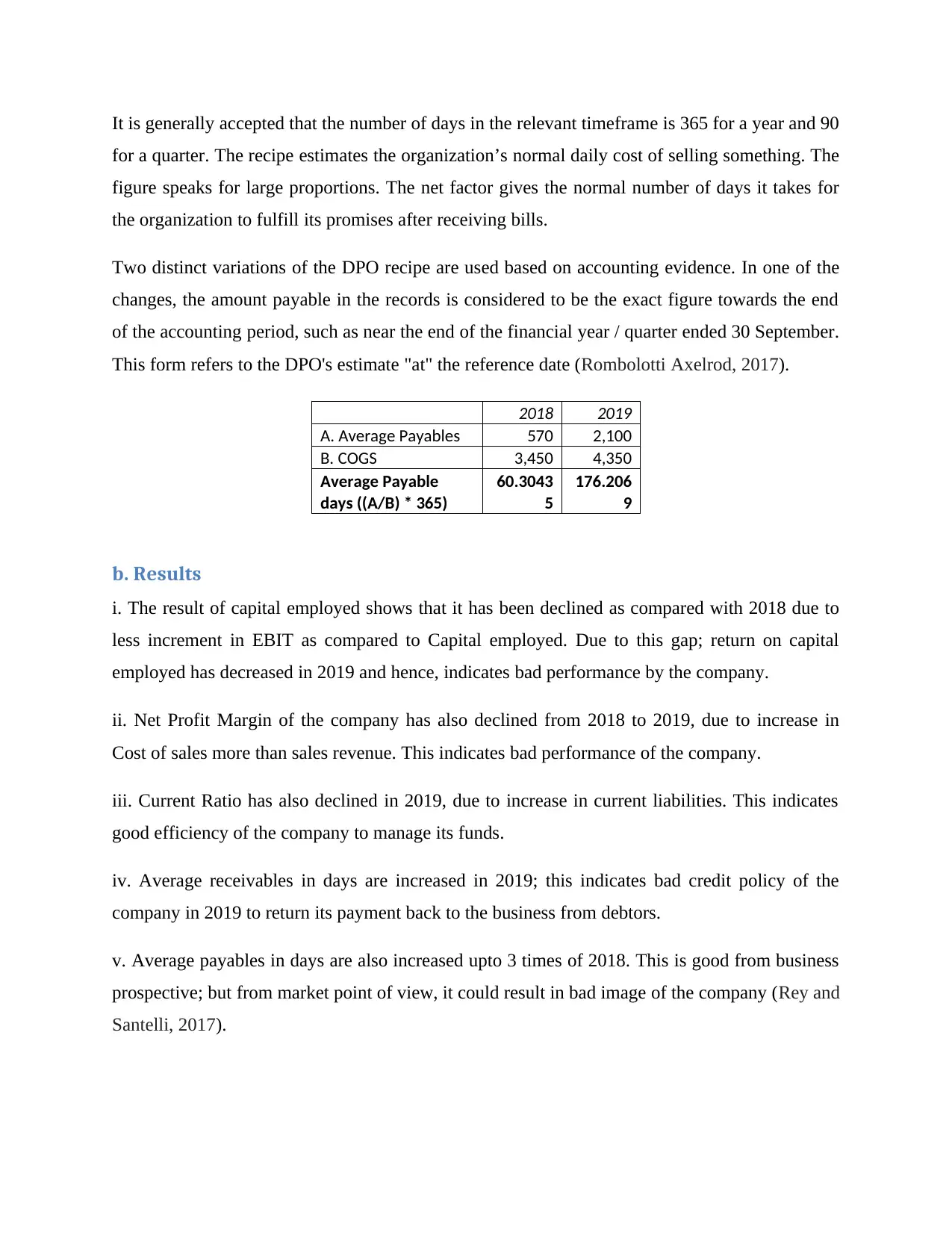
It is generally accepted that the number of days in the relevant timeframe is 365 for a year and 90
for a quarter. The recipe estimates the organization’s normal daily cost of selling something. The
figure speaks for large proportions. The net factor gives the normal number of days it takes for
the organization to fulfill its promises after receiving bills.
Two distinct variations of the DPO recipe are used based on accounting evidence. In one of the
changes, the amount payable in the records is considered to be the exact figure towards the end
of the accounting period, such as near the end of the financial year / quarter ended 30 September.
This form refers to the DPO's estimate "at" the reference date (Rombolotti Axelrod, 2017).
2018 2019
A. Average Payables 570 2,100
B. COGS 3,450 4,350
Average Payable
days ((A/B) * 365)
60.3043
5
176.206
9
b. Results
i. The result of capital employed shows that it has been declined as compared with 2018 due to
less increment in EBIT as compared to Capital employed. Due to this gap; return on capital
employed has decreased in 2019 and hence, indicates bad performance by the company.
ii. Net Profit Margin of the company has also declined from 2018 to 2019, due to increase in
Cost of sales more than sales revenue. This indicates bad performance of the company.
iii. Current Ratio has also declined in 2019, due to increase in current liabilities. This indicates
good efficiency of the company to manage its funds.
iv. Average receivables in days are increased in 2019; this indicates bad credit policy of the
company in 2019 to return its payment back to the business from debtors.
v. Average payables in days are also increased upto 3 times of 2018. This is good from business
prospective; but from market point of view, it could result in bad image of the company (Rey and
Santelli, 2017).
for a quarter. The recipe estimates the organization’s normal daily cost of selling something. The
figure speaks for large proportions. The net factor gives the normal number of days it takes for
the organization to fulfill its promises after receiving bills.
Two distinct variations of the DPO recipe are used based on accounting evidence. In one of the
changes, the amount payable in the records is considered to be the exact figure towards the end
of the accounting period, such as near the end of the financial year / quarter ended 30 September.
This form refers to the DPO's estimate "at" the reference date (Rombolotti Axelrod, 2017).
2018 2019
A. Average Payables 570 2,100
B. COGS 3,450 4,350
Average Payable
days ((A/B) * 365)
60.3043
5
176.206
9
b. Results
i. The result of capital employed shows that it has been declined as compared with 2018 due to
less increment in EBIT as compared to Capital employed. Due to this gap; return on capital
employed has decreased in 2019 and hence, indicates bad performance by the company.
ii. Net Profit Margin of the company has also declined from 2018 to 2019, due to increase in
Cost of sales more than sales revenue. This indicates bad performance of the company.
iii. Current Ratio has also declined in 2019, due to increase in current liabilities. This indicates
good efficiency of the company to manage its funds.
iv. Average receivables in days are increased in 2019; this indicates bad credit policy of the
company in 2019 to return its payment back to the business from debtors.
v. Average payables in days are also increased upto 3 times of 2018. This is good from business
prospective; but from market point of view, it could result in bad image of the company (Rey and
Santelli, 2017).
⊘ This is a preview!⊘
Do you want full access?
Subscribe today to unlock all pages.

Trusted by 1+ million students worldwide
1 out of 13
Related Documents
Your All-in-One AI-Powered Toolkit for Academic Success.
+13062052269
info@desklib.com
Available 24*7 on WhatsApp / Email
![[object Object]](/_next/static/media/star-bottom.7253800d.svg)
Unlock your academic potential
Copyright © 2020–2025 A2Z Services. All Rights Reserved. Developed and managed by ZUCOL.





